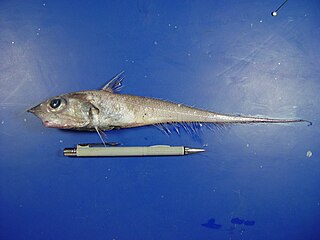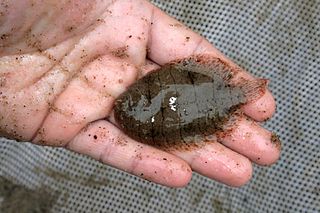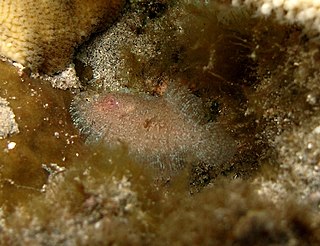
A flatfish is a member of the ray-finned demersal fish order Pleuronectiformes, also called the Heterosomata, sometimes classified as a suborder of Perciformes. In many species, both eyes lie on one side of the head, one or the other migrating through or around the head during development. Some species face their left sides upward, some face their right sides upward, and others face either side upward.

Grenadiers or rattails are generally large, brown to black gadiform marine fish of the subfamily Macrourinae, the largest subfamily of the family Macrouridae. Found at great depths from the Arctic to Antarctic, members of this subfamily are amongst the most abundant of the deep-sea fish.

Citharichthys is a genus of flatfish in the large-tooth flounder family, Paralichthyidae. They have both eyes on the left sides of their heads. They are native to the oceans around the Americas, with a single species, C. stampflii off the West African coast. Most are found in relatively shallow depths, but the genus also includes species found in deep water and species that enter fresh water.

Tonguefishes are flatfish in the family Cynoglossidae. They are distinguished by the presence of a long hook on the snout overhanging the mouth, and the absence of pectoral fins. Their eyes are both on the left side of their bodies, which also lack a pelvic fin. This family has three genera with a total of more than 140 species. The largest reaches a length of 66 cm (26 in), though most species only reach half that size or less. They are found in tropical and subtropical oceans, mainly in shallow waters and estuaries, though some species are found in deep sea floors, and even a few in rivers.

Gymnothorax is a genus of fish in the family Muraenidae found in Atlantic, Indian and Pacific Ocean. With more than 120 species, it the most speciose genus of moray eels.

Coelorinchus is a genus of rattail fish.

Coryphaenoides is a genus of rattails which is found in all oceans of the world. They are found in deep waters and C. yaquinae, recorded to 7,012 m (23,005 ft), is the only member in the family known from the hadal zone.
Bathygadus is a genus of rattails of the family Bathygadidae.

Nezumia is a genus of rattails. The generic name derives from the Japanese 鼠 (nezumi), meaning "mouse".

Symphurus thermophilus is a species of tonguefish notable for being the only flatfish known to be an obligate inhabitant of hydrothermal vents. It is known from several widely dispersed locations in the western Pacific Ocean and occurs in great numbers. They are tolerant of harsh conditions and are often found in close association with elemental sulfur, including molten sulfur pools that exceed 180 °C in temperature. As they are not significantly different in appearance and feeding habits from other tonguefishes, they are thought to be relatively recent colonizers of vent ecosystems.

Cynoglossus is a genus of fish in the family Cynoglossidae. Most species are indigenous to the Indo-Pacific region, but there are also a few in warmer parts of the East Atlantic. They are commonly found in shallow waters on a muddy or sandy bottom, including estuaries and a few species are restricted to fresh water. One species Cynoglossus sinusarabici has invaded the Mediterranean Sea through the Suez Canal from the Red Sea, a process known as Lessepsian or Erythrean migration.

Rhynchoconger is a genus of eels in the family Congridae.

Trinectes is a genus of American soles native to the Americas. Most species are coastal, occurring in both salt and brackish water, but several may enter fresh water and one, T. hubbsbollinger, is restricted to rivers. They are fairly small, with the largest species only reaching 25 cm (9.8 in) in length.

Parabothus is a genus of fish in the family Bothidae native to the Indian and Pacific Ocean.

Aseraggodes is a genus of soles native to the Indian and Pacific oceans. These small flatfishes are poisonous.

Peristedion is a genus of marine ray-finned fish belonging to the family Peristediidae, the armoured gurnards or armored sea robins. These fishes are found in Atlantic and Indo-West Pacific ocean waters.

The northern tonguefish is a species of fish belonging to the family Cynoglossidae.

Verena Julia Tunnicliffe is a Canadian Marine Biologist and Professor of the University of Victoria. Since 2002, she has held the position of Canada Research Chair in Deep Ocean Research. Her research on hydrothermal systems helped establish Canada's first Endeavor Hot Vents Marine Protected Area. Her research has also led to the discovery of over 80 new species of marine life.
Lycodinae is a subfamily of marine ray-finned fish belonging to the family Zoarcidae, the eelpouts. These eelpouts are found are in all the world's oceans, with a number of species being found off southern South America.

Daikoku Seamount is an active volcanic seamount in the Northern Mariana Islands of the United States. This underwater volcano is located in the northern end of the Mariana Islands range.



















